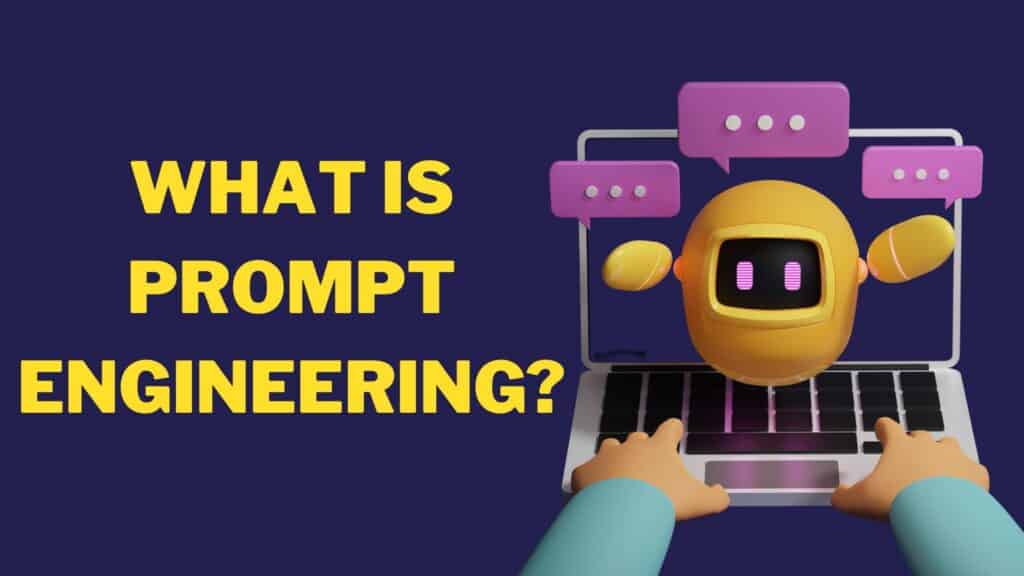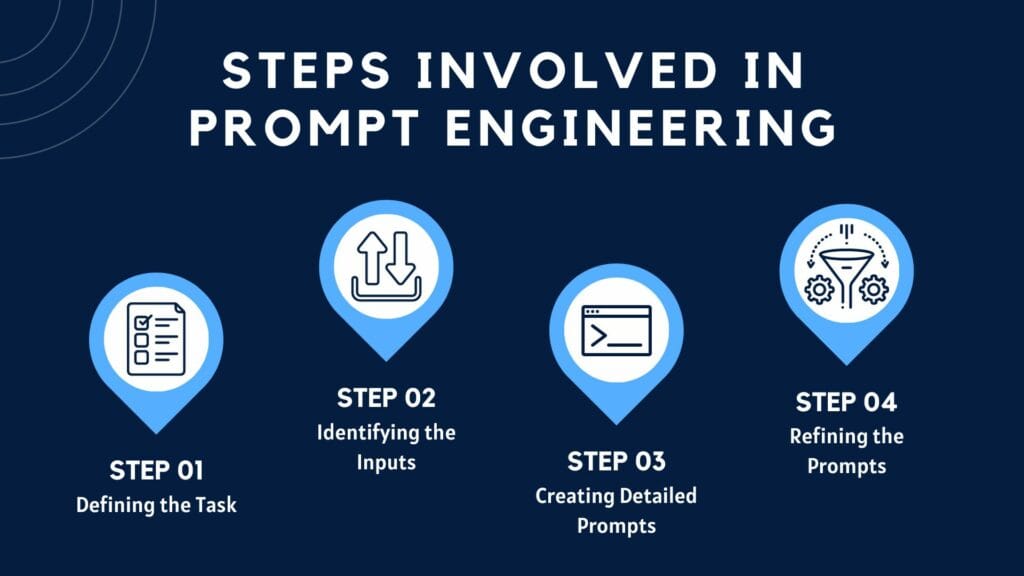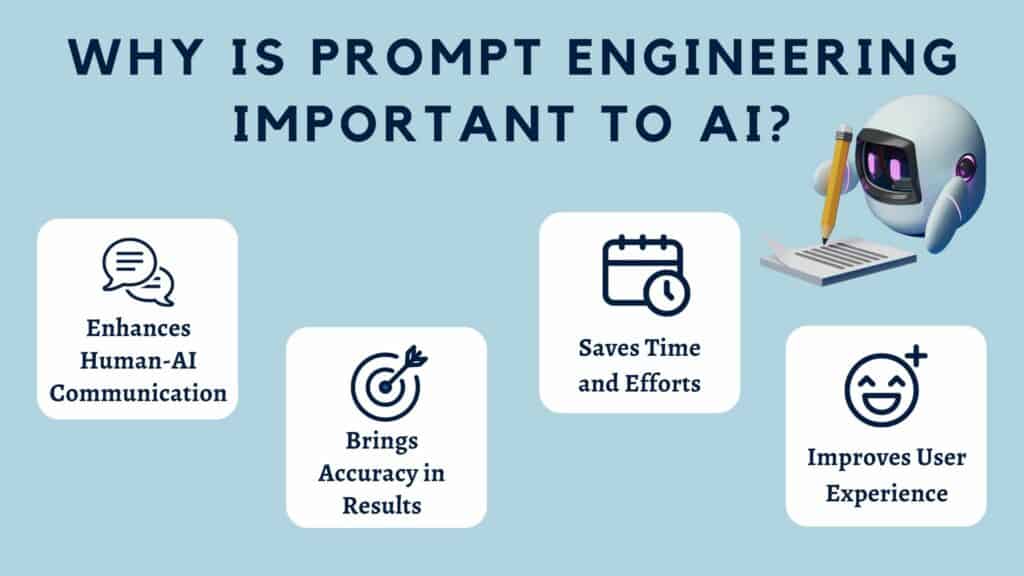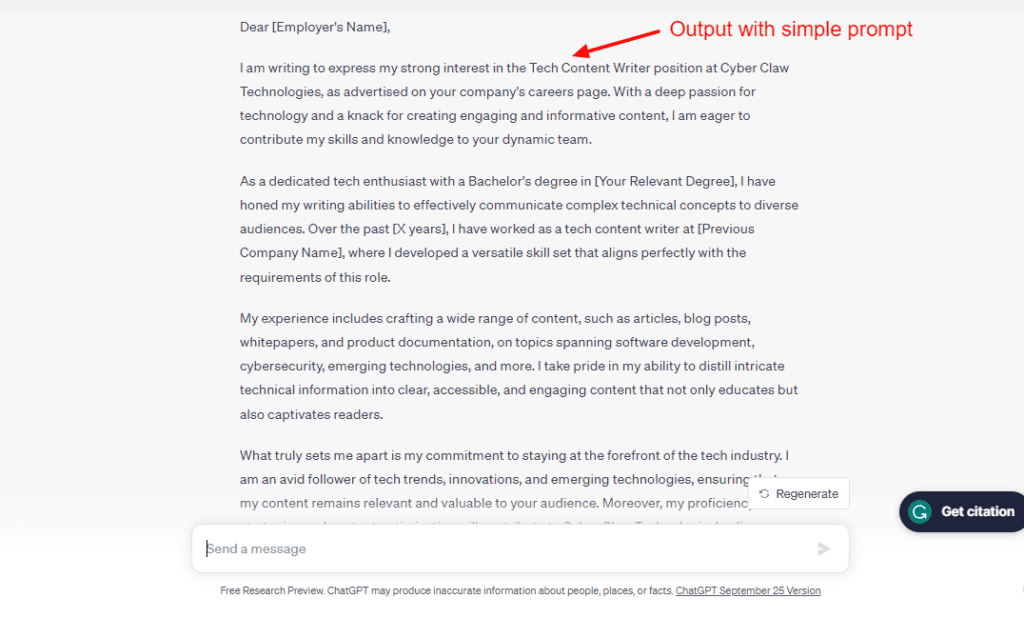Do you constantly struggle with getting satisfactory outputs from AI systems like ChatGPT? Do you fail to make them understand and fulfill your commands? Well, you’re not alone. Most people prompt AI platforms in the wrong way, resulting in irrelevant results.
Wondering if there’s a smarter and more efficient way to interact with AI technology? The answer is Prompt Engineering! This fascinating concept is revolutionizing how we communicate with machines.
In this article, we’re going to talk about “What is Prompt Engineering”. We’ll begin by understanding what it is, how it works, why it’s important, and what its use cases are. We’ll also look at some examples and discover how to learn Prompt Engineering and get a job in the field!
So, are you ready to dive into the fascinating world of prompt engineering? Let’s dive in and discover how to command and converse with AI in ways you never thought possible!
What is Prompt Engineering?
To understand prompt engineering, let’s first address what prompts are. Prompts are simply lines of text describing what you need the AI tools to accomplish. Some simple examples of prompts may be:
- “Write an email asking for 3 days’ leave from my manager.”
- “Create a line drawing of a koala riding a bike on Mars.”
Sounds familiar? Well, if you’ve ever used an AI-powered platform like ChatGPT or Midjourney, the description you enter in your text field is referred to as the prompt. It’s important to note that your output is only as good as the inputs you provide.
This is where Prompt Engineering comes into play. It is a popular technique used in the field of artificial intelligence. Prompt Engineering is the process of carefully constructing text-based prompts to produce desired results from an AI model.
This helps in producing more reliable results and making AI tools more user-friendly for general audiences. Individuals who can effectively communicate with Generative AI tools (like ChatGPT, Bard, Midjourney, Dall-E, etc.) to produce efficient results are called Prompt Engineers.
How Does Prompt Engineering Work?
Prompt engineering makes optimal use of the capacities of different AI language models and image models. Rather than relying on pre-trained outputs generated by AI, it passes the control into the hands of professionals. They modify the inputs to generate the desired responses.
This process involves various steps. Let’s look at them in detail.
Step 1: Defining the Task
In this step, you need to clearly define what you want the AI model to do. This may include tasks like translating a paragraph, writing an email, brainstorming ideas, etc.
Step 2: Identifying the Inputs
In the next step, you need to carefully analyze the inputs that need to be provided to the AI tool to generate the outcomes you expect.
For instance, if you wish to create a job application email, you need to provide it with details on your experience, skills, the receiving company’s details, etc.
Step 3: Creating Detailed Prompts
Once you identify the inputs, you need to create prompts with all of that information. They must include all the relevant data so that the AI tool can process it and generate streamlined results.
Step 4: Refining Prompts
After the initial outputs are generated, you need to edit and rephrase the prompts to generate better results. This trial-and-error process continues until you create efficient prompts.
Examples of Prompt Engineering
There is a wide range of use cases of prompt engineering in the real world today. The following are the most popular examples.
1) Customer Support Chatbots
Companies use prompt engineering to create effective prompts for extracting relevant information from their customers through AI chatbots.
2) Language Translation
Through prompt engineering, you can generate accurate translations for any language pair. The prompt engineer simply needs to specify the source and target languages, along with a few example translations.
3) Answering Questions
With prompt engineering, pairs of example questions and answers can be supplied to the AI model. Then it can be effectively prompted to generate appropriate answers to users’ questions.
4) Text Summarization
Similarly, the AI model can be guided to create concise and crisp summaries of any text provided to them. For this, they can be trained using a few examples of text-to-summary conversions.
5) Code Generation
With prompt engineering, accurate and functional code snippets can be created for any application. Prompt engineers can supply it with relevant code examples of desired outcomes to prompt certain types of responses.
Why is Prompt Engineering Important to AI?
According to Gartner, by 2025, Generative AI is expected to account for up to 10% of all content produced globally. Crazy how fast AI is evolving, right? Upskilling yourself has become the need of the hour.
Prompt Engineering is one such skill that will help you stay on top of the game. But why is it so important to AI? Let’s discuss the benefits below.
1) Enhances Human-AI Communication
Prompt engineering is an excellent way to interact with AI in a meaningful way. It helps humans leverage AI technology to communicate their intentions and generate desired results.
2) Brings Accuracy in Results
Through prompt engineering, you can specify your request in a clear and concise manner to the AI platform. This helps ensure the outputs produced are relevant to your use case. You can tweak the input prompt to generate exactly what you want.
3) Saves Time and Efforts
Once a well-designed prompt is created, it can be repurposed for a variety of use cases. This helps in saving a lot of time spent in rephrasing the same queries. It also prevents inconsistencies in results, as all further outputs are generated with a single prompt template.
4) Improves User Experience
When users implement the prompts crafted by prompt engineers, they tend to generate targeted results with little back and forth. Thus, their overall experience undergoes significant improvement.
What Does a Prompt Engineer Do?
Now that you’ve understood how prompt engineering works, let’s understand the work of a prompt engineer with a simple example.
There’s an IT company. It has allocated teams for handling different departments, like social media, marketing, sales, etc. If a prompt engineer is assigned to the social media team, they will begin by gaining a deep understanding of the tasks performed by the team.
Then they will design and test out different prompts the team should use to accomplish those tasks. The outputs are carefully evaluated for reliability and consistency. This trial-and-error process may take a week or an entire month, depending on the complexity of the task.
Once the perfect prompt is crafted, they keep on testing, refining, and updating it regularly as per the latest technologies like ChatGPT, Claude, Bard, Midjourney, etc. Then they pass them on to the entire team.
Thus, the job of a prompt engineer is to craft, refine, and update prompts in order to maximize the efficiency of all members of a team.
Why are Lucrative Salary Packages Being Offered to Prompt Engineers?
If you’ve ever scrolled through listings on job portals, you might’ve noticed how AI prompt engineering jobs are offered packages literally in crores! Baffling, right? For a profession that just came into existence, its value is unbelievable and quite unreasonable.
However, there are reasons for its popularity. One of the major reasons Prompt Engineers are offered such hefty salaries is because they improve the efficiency of the entire team. The prompts they create take the team’s productivity and efficiency to a whole new level.
And for that, they deserve that salary package. In fact, companies are actively looking for people who can understand the work of every department and simplify their tasks through AI technology.
Does Learning Prompt Engineering Guarantee a Hefty Salary Package?
Well, before you get all hyped up, let me debunk this common myth. Not everyone is going to get that 2 Cr salary package!
The truth is that people who are being offered such salaries were already skilled in their respective fields even before the existence of prompt engineering. These professionals possess immense skills in diverse fields, like coding, design, engineering, and more.
Effective prompts can only be crafted by individuals with a good knowledge base concerning the particular field.
For instance, you can’t write prompts related to software or apps if you’re unaware of the software development lifecycle. You can’t write prompts for AI image generation if you’re not equipped with the technical terms used in the field.
Thus, deep subject matter expertise and clarity of basic concepts are essential for crafting the best prompts. Having Prompt Engineering as a skill set on top of their existing skills gives professionals an edge compared to others. It may take a few years for a beginner to reach that level.
Another question that may arise here is, “If organizations are hiring prompt engineers, does that mean existing employees will be pushed out?” Well, that’s not the case.
Prompt Engineering is definitely going to become a large category for hiring in the future. However, the existing jobs would continue to operate as well. The only difference would be that upskilling employees would become crucial for keeping up with the latest technologies.
How to Write a Good Prompt?
Let’s understand how to write a good prompt with the help of a simple example. For instance, you want to write a cover letter for applying to a job as a tech content writer. Here’s a basic prompt most people would write.
“Write a cover letter for a job application for the post of tech content writer at Cyber Claw Technologies.” Let’s execute the above query in ChatGPT and see the results produced.
The cover letter generated is extremely wordy and keeps going on for paragraphs! It’s also quite generic and not personalized for our specific use case.
Now, let’s try a more detailed way of prompting ChatGPT. I call it the “God Level Prompt”. Let me disclose all the elements of a God Level Prompt below.
Step 1: Set a Role
The initial step is to designate a role for the AI. So, whatever task you want it to do, you need to assign it a role in that industry to align your results in a particular direction. For example, we can start with:
“Act as a professional writer specializing in writing CVs and cover letters for individuals.”
Step 2: Provide Context
The next step is to personalize the results according to your requirements. Here, you need to provide a detailed context for it to generate effective results. The context could be something like this:
“I am seeking a job in the writing industry. I have 3 years of experience in the field of technical writing. My skills are – Writing, Editing, SEO, Graphic Design, and AI. I have also done multiple freelance projects in the same genre and boosted the traffic and sales of websites. I am a hardworking and dedicated professional who respects time and is a team worker.”
Step 3: Assign a Task
Now, you need to specify the task you need it to fulfill for you. Let’s specify it like this:
“I need you to help me write a cover letter for a job application for the post of tech content writer at Cyber Claw Technologies. It is an esteemed startup that reviews digital tools and software for small businesses and entrepreneurs.”
Step 4: Describe the Output
Next, you need to describe the type of output you need it to produce. For instance,
“Please write the cover letter in three paragraphs. The first paragraph will have a description about me and my skills. Second one will highlight why I will be an asset to their company. And third one will be a small paragraph asking for the further steps. Use engaging and polite words and bullet points wherever possible.”
Step 5: Insert Negative Prompts
Here, you can specify what you do not wish to include in your desired output. For instance,
“Do not exceed 300 words in total and do not include any slang, emoticons, marketing, or buzz words.”
Step 6: Specify a Tone
Finally, mention the tone you need for your cover letter.
“Use a friendly tone.”
Now we will compile this entire AI prompt together and run it in ChatGPT. It’s around 200 words in total.
As you can see, the results generated by the second prompt are much more streamlined to your personal needs as compared to the first one.
Professional prompts are anywhere between 300 to 1000 words. They may even be longer than the result they generate, but the advantage is that you can use them as a template for all future content generations!
How to Become a Prompt Engineer?
It’s one of the most trending questions these days. Prompt engineering appears to be a lucrative field, which certainly sparks everyone’s curiosity. But before you dive headlong into it, let’s address some key questions regarding the field of Prompt Engineering.
Does Prompt Engineering Require Coding?
Although coding skill is not the most important aspect of prompt engineering, it would definitely give you an upper hand over others. Most employers look for a background in software engineering and computer science while hiring prompt engineers.
What Technical Skills Does an AI Prompt Engineer Need?
The most important skill you should have is the apt knowledge of different AI language model and their working processes.
You should have a fairly good knowledge of AI and large language models (LLMs), machine learning, Python, Data science and analysis, Natural Language Processing (NLP), and a grasp of technical concepts.
What Non-Technical Skills Does a Prompt Engineer Need?
Apart from this, you should also possess strong soft skills like written and verbal communication, analytical skills, knowledge of language and human psychology, etc. All of these skills will help you create, refine, and update prompts in a much better manner.
How to Learn Prompt Engineering?
There are dozens of free and paid courses available online that teach you the basics of prompt engineering. You can find them on platforms like YouTube, Udemy, Coursera, etc. I’ve listed some free resources below for you to get a comprehensive understanding of Prompt Engineering.
- Prompt Engineering Guide
- Prompt Engineering for ChatGPT (Coursera)
- ChatGPT Prompt Engineering for Beginners (Udemy)
- Prompt Engineering Mastery Series (YouTube)
Conclusion
Prompt engineering is the future of our generation. The key to unlocking the real potential of AI lies in this revolutionary concept. In this article, I have tried to clarify the basic concepts around it. I hope you found something valuable from this information.
If you’re a blogger or content writer, you can check out my favorite ChatGPT SEO Strategies for generating better content.
Anyway, what do you think about prompt engineering? Is it overrated? Will it stick around for the long term? Or is it just a fad that’ll die down, eventually? Have you tried learning prompt engineering? Do share your experiences with me in the comments box below.
This is Kripesh, taking your leave. I’ll be back with more insightful posts soon. Till then, keep learning and upskilling yourself. Cheers! 🙂







